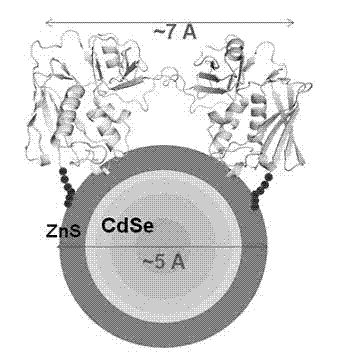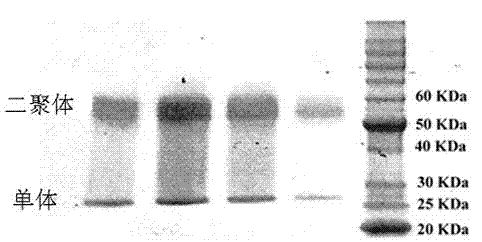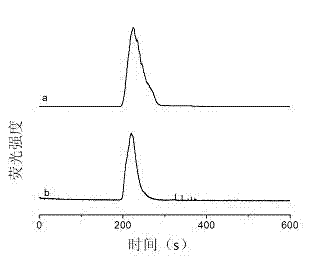Method for labeling protein through quantum dots
A technology for labeling proteins and quantum dots, applied in the field of nanobiology, can solve the problems of poor stability of proteins and QDs, achieve high repeatability, simple operation methods, and solve instability effects
- Summary
- Abstract
- Description
- Claims
- Application Information
AI Technical Summary
Problems solved by technology
Method used
Image
Examples
Embodiment 1
[0018] SpeA protein expression with Histag
[0019] The SpeA gene was purchased from Genscript and expressed in Escherichia coli (E. coli). The gene was cloned into the NdeI and EcoRI sites of the pET28a vector to obtain a high-yield expression plasmid pJX2, which contained the full-length SPEA protein and the N-terminal Histag. Plasmid pJX2 was introduced into E. coli by electroporation. After the recombinant gene is transformed into the E. coli strain, it is induced to express the target protein in the host bacteria through temperature control, and the expression sample is subjected to SDS-PAGE to detect the expressed protein. SpeA will form a dimeric structure in the solution ( figure 2 ).
[0020] After mixing SpeA and CdSe / Zns quantum dots at a molar ratio of 8:1, shake for 30 minutes, and the SpeA dimer is combined with the quantum dots through histidine to obtain a SpeA-QD complex ( figure 1 ).
[0021] To test the stability of SpeA binding to QDs, after mixing QD...
Embodiment 2
[0023] The quantum dots used are CdTe / ZnS, the molar ratio of protein to quantum dots is 4:1, other steps are the same as in Example 1.
Embodiment 3
[0025] The quantum dots used are CdSe / ZnSe, the molar ratio of protein to quantum dots is 16:1, and other steps are the same as in Example 1.
[0026] It can be seen from the above three examples that the present invention can realize the rapid combination of quantum dots and SpeA protein dimer, and has high stability and convenient operation.
PUM
 Login to View More
Login to View More Abstract
Description
Claims
Application Information
 Login to View More
Login to View More - R&D
- Intellectual Property
- Life Sciences
- Materials
- Tech Scout
- Unparalleled Data Quality
- Higher Quality Content
- 60% Fewer Hallucinations
Browse by: Latest US Patents, China's latest patents, Technical Efficacy Thesaurus, Application Domain, Technology Topic, Popular Technical Reports.
© 2025 PatSnap. All rights reserved.Legal|Privacy policy|Modern Slavery Act Transparency Statement|Sitemap|About US| Contact US: help@patsnap.com



